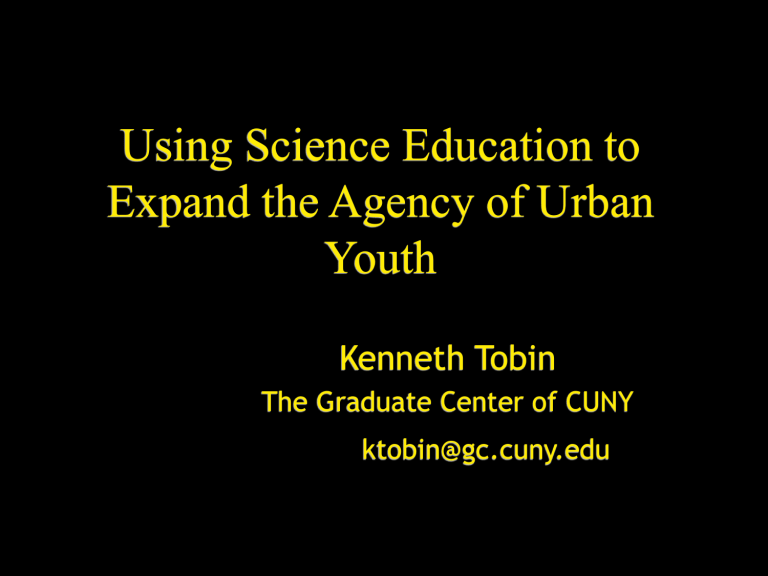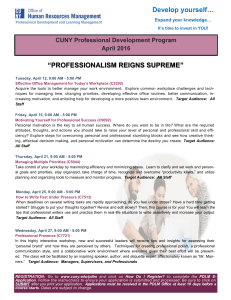Using Science Education to Expand the Agency of Urban Youth Kenneth Tobin

Using Science Education to
Expand the Agency of Urban
Youth
Kenneth Tobin
The Graduate Center of CUNY ktobin@gc.cuny.edu
Why science education?
Power discourse--gateway to social advancement
Meet graduation requirements
Doorway to further learning and careers
Aesthetic reasons
Useful to meet and change goals in out of school fields
About science…
Form of culture that seeks to explain/understand, and in some cases control, the experienced events and phenomena of the universe (of the natural world)
System of practices and associated schema
(always both)
Enacted by participants in a variety of fields including classrooms and test/examination sites
Thoughts on science achievement
Enacting science (as culture) within fields.
Ways of participating reflect position in a field
Legitimate peripheral
Central
Dynamic
Conscious | Unconscious
The fields of school science
Subject matter (e.g. chemistry)
Whole class interactive
Small group discussions
Individualized
At the chalkboard
The back row
Labs
Demonstrations
Field trips
Internet and computers
Homework
Key points about fields
Structured with resources
Material (e.g., space, physical environment, equipment, supplies, aids, practices of participants)
Schematic (e.g., conventions, rules, ideologies, hegemonies, concepts, values, feelings, status and other identity markers)
Social (e.g., networks, tools such as language aptitude)
Support characteristic forms of culture
Have porous boundaries
Boundary crossing
Peripheral versus Central
Intermingled with culture from other fields
Misses opportunities to participate
Reliant on scaffolds from others
Error prone
Limited self correcting
Mainly conscious actions
Appropriate
Just in time
Anticipatory
Fluent
Autonomous
Self-correcting
Responsive
Increasingly unconscious
Urban Science
Teachers and students differ in culture, social class, age, and often gender
Achievement measures require science to be done “on demand” including paper and pencil tests, computers, and lab tasks.
Well-advertised achievement gaps between urban and suburban schools
Strident differences in resources (teachers, equipment, buildings) to support urban science education
Learning as cultural production
Reproduction | Transformation
Enactment utilizes practices and schema from other fields
Is enactment legitimate peripheral or is it outside the border (non-canonical)?
Which parts of culture, from each side of the border, are foundational for producing science?
Learning as expanded agency
Agency | Structure
Agency is the power to act; to appropriate the structures of a field
Appropriation implies intentions/goals plus capital to access and use resources for individual | collective interests
Capital spiral (cutural<->social<->symbolic)
Successful interactions chains produce webs of entrainment -- interactions are anticipated and appropriated by others
Teaching for success
Identify and support the enactment of foundational culture (from in and outside of the school)
Minimize disruptions (breaching/shut downs)
Minimize the incidence and duration of unsuccessful interactions
Maximize the incidence and duration of successful interactions
Emotional climate
Minimize
anger
frustration
boredom
disappointment
annoyance
irritation
dissatisfaction
controlled
failure
“dissed, missed, pissed”
Maximize
enjoyment,
happiness
interest
satisfaction
freedom
independence
successful
challenged
respected
valued
Challenges to culturally adaptive teaching
Erase deficit perspectives in an EITHER-OR sense (deficit | capital)
Recognize and encourage foundational culture
Identify teaching culture that shuts down student production
Produce teaching culture that affords student enactment and success
Increase incidence of coteaching
Increase evaluation by self, peer, and teacher
Successfully interact across borders
Challenges to culturally adaptive learning
Earn and maintain respect of peers
Read and successfully interact with the culture of the teacher (i.e., learn to interact successfully across borders)
Produce new identities through participation in science
Appropriate structures to enact science
Toward a science community
Mutual focus
Synchrony
Anticipation leads to fluent enactment
Chains of successful interactions occur
Increase in positive emotional energy
Solidarity emerges
Peer teaching
Respect
Got your back
Individual | Collective
All for one and one for all
Monitoring the Emotional
Climate of Urban Science
Classrooms
Kenneth Tobin
The Graduate Center of CUNY ktobin@gc.cuny.edu
General orientation to participant research
Search for patterns and contradictions in relation to:
the buzz and emotional climate of the classroom over space and time
Interactions with others and materials
Verbal
Non verbal
Obtain and learn from multiple perspectives of participants (honor diverse perspectives)
The background noise
Is there a working buzz?
Is there evidence of:
Negative emotions?
Positive emotions?
Efforts to disrupt?
Efforts to support?
Efforts to disrespect?
Efforts to show respect?
Is there evidence of positive, negative or neutral emotional energy?
Interactions with materials
Are participants interacting with materials to meet their goals?
Do successful interactions with materials afford other interactions to occur and succeed?
What emotions are associated with interactions with materials?
To what extent are the interactions with materials “as intended,” anticipated by others, and affording of interaction chains occurring?
Interactions among participants
In what ways are oral contributions picked up by others?
Is there evidence of attentive listening?
To what extent are utterances fluent?
Are utterances anticipated by others?
To what extent do utterances show evidence of verve?
Non verbal interactions
Body orientation and movement
Eye gaze and contact
Head movements and orientation
Smiles, frowns and facial expressions
Gestures
Pointing with fingers, hands and the body
(e.g., head)
Are movements high or low energy?
Teaching and Learning
Science Across Social and
Cultural Boundaries
Kenneth Tobin
The Graduate Center of CUNY ktobin@gc.cuny.edu
Setting Up Cogenerative
Dialogues
Dialogues among participants about shared experiences
Size of group can vary but it is best to start with small groups containing 1-2 students
Select student participants based on differences
Invite other participants based on their participation
Goals of Cogenerative
Dialogues
Improve the quality of learning
Improve the quality of teaching
Identify and resolve contradictions
Arrive at consensus on changes needed in roles, rules, and classroom structures
Collective responsibility for enacting changes
Rules for Cogenerative
Dialogues
Listen attentively
Try to understand others’ contributions
Show respect for all participants (always)
Address previous contributions
Maintain focus
Restrict time of utterances
Do not interrupt or be a turn shark
Strive for consensus
Outcomes of Cogenerative
Dialogues
Learn to interact successfully across boundaries defined by race, ethnicity, class, age and gender
Identity changes
Synchrony
Solidarity
Mutual focus
Resources to support cogenerative dialogues
Video tapes of classes, digital photos, artifacts, qualitative and quantitative data
Invited peripheral participants such as school administrators, university teacher educators, former students, and parents
Regular occurrence (1-2 times a week)
Group size can vary along a continuum from one on one to whole class
Coteaching to improve the learning of urban science
Kenneth Tobin
The Graduate Center of CUNY ktobin@gc.cuny.edu
Coteaching scenarios
Resident teacher with one or more new teachers
Resident teachers from the same school or department
Advisory teachers, administrators, teacher educators and researchers with resident teachers
Many coteachers with many students
Students adopting coteaching roles
Structuring coteaching
Negotiate central and peripheral roles
Stepping forward and stepping back
Tutoring
Huddles
Cogenerative dialogues within an ongoing class
Focus on the learning of students
Outcomes of coteaching
Becoming like the other
Responsive to forms of diversity
Students experience much more teaching and are highly involved
Can learn from others by being with them while enacting culture and also by stepping back to observe from the side (tracking another)
Policy Issues
New teachers learning to teach
Induction for newly hired teachers
(experienced and inexperienced)
Learning subject matter
Teaching out of field
Teacher assessment and evaluation
Expanding roles of students, parents and the community
